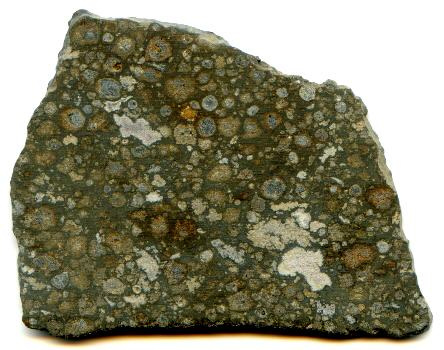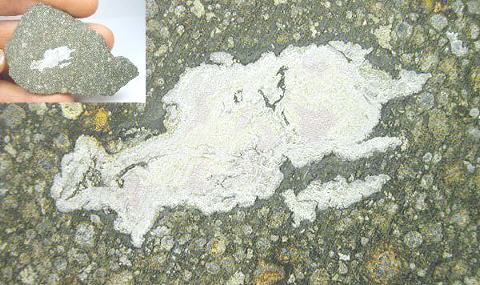CV3.3 (3.1–3.4)oxB

Found 2003
no coordinates recorded Numerous pieces of a carbonaceous chondriteCarbonaceous chondrites represent the most primitive rock samples of our solar system. This rare (less than 5% of all meteorite falls) class of meteorites are a time capsule from the earliest days in the formation of our solar system. They are divided into the following compositional groups that, other than Click on Term to Read More, having a combined weight of 780 g, were found in Northwest Africa and subsequently sold in the Rissani meteoriteWork in progress. A solid natural object reaching a planet’s surface from interplanetary space. Solid portion of a meteoroid that survives its fall to Earth, or some other body. Meteorites are classified as stony meteorites, iron meteorites, and stony-iron meteorites. These groups are further divided according to their mineralogy and Click on Term to Read More market. Northwest Africa 2086 was analyzed and classified as an unshocked (S1 = <5 GPa) CV3 that exhibits only minor terrestrial weathering (W1). In-depth analyses of NWA 2086 were conducted at the University of Szeged, Hungary (Fintor et al., 2013), and it was determined that this chondriteChondrites are the most common meteorites accounting for ~84% of falls. Chondrites are comprised mostly of Fe- and Mg-bearing silicate minerals (found in both chondrules and fine grained matrix), reduced Fe/Ni metal (found in various states like large blebs, small grains and/or even chondrule rims), and various refractory inclusions (such Click on Term to Read More is a member of the CV3-reduced subgroup. Many petrographic features of NWA 2086 are consistent with those observed in reducedOxidation and reduction together are called redox (reduction and oxidation) and generally characterized by the transfer of electrons between chemical species, like molecules, atoms or ions, where one species undergoes oxidation, a loss of electrons, while another species undergoes reduction, a gain of electrons. This transfer of electrons between reactants Click on Term to Read More CV3 chondritesChondrites are the most common meteorites accounting for ~84% of falls. Chondrites are comprised mostly of Fe- and Mg-bearing silicate minerals (found in both chondrules and fine grained matrix), reduced Fe/Ni metal (found in various states like large blebs, small grains and/or even chondrule rims), and various refractory inclusions (such Click on Term to Read More such as Vigarano, Efremovka, and Leoville; e.g., and close similarities were observed in both the chondruleRoughly spherical aggregate of coarse crystals formed from the rapid cooling and solidification of a melt at ~1400 ° C. Large numbers of chondrules are found in all chondrites except for the CI group of carbonaceous chondrites. Chondrules are typically 0.5-2 mm in diameter and are usually composed of olivine Click on Term to Read More types (primarily plagioclase-rich with porphyritic rims) and CAISub-millimeter to centimeter-sized amorphous objects found typically in carbonaceous chondrites and ranging in color from white to greyish white and even light pink. CAIs have occasionally been found in ordinary chondrites, such as the L3.00 chondrite, NWA 8276 (Sara Russell, 2016). CAIs are also known as refractory inclusions since they Click on Term to Read More types among these meteorites. However, the significant hydrothermal alteration observed in this meteorite is similar to that in the oxidizedOxidation and reduction together are called redox (reduction and oxidation) and generally characterized by the transfer of electrons between chemical species, like molecules, atoms or ions, where one species undergoes oxidation, a loss of electrons, while another species undergoes reduction, a gain of electrons. This transfer of electrons between reactants Click on Term to Read More Allende-like chondrites. By comparison, the relatively high matrixFine grained primary and silicate-rich material in chondrites that surrounds chondrules, refractory inclusions (like CAIs), breccia clasts and other constituents. Click on Term to Read More:chondrule ratio of 52:48 for NWA 2086 is most similar to that of the CV3oxB group, although this could be due in part to a high degree of pre-accetionary comminution of the chondrulesRoughly spherical aggregate of coarse crystals formed from the rapid cooling and solidification of a melt at ~1400 ° C. Large numbers of chondrules are found in all chondrites except for the CI group of carbonaceous chondrites. Chondrules are typically 0.5-2 mm in diameter and are usually composed of olivine Click on Term to Read More which constitute the NWA 2086 matrix (Kereszturi et al., 2014). A subgroup designation of CVoxB is used here for NWA 2086 in accord with Dunn et al. (2016). The 887 g CV3 NWA 10670 is probably paired with NWA 2086 (R. Bartoschewitz, MetBull 105).
Chondrules are present in a variety of types including poikilitic, granular, porphyritic, barred, and glassy, with about 20% of these having layered rims formed through accretionary processes and sometimes displaying subsequent aqueous alteration modification (Kereszturi
et al., 2014). This alteration has similarly affected the matrix, and a progression of alteration is observed in a decreasing Si and Mg content from the chondrule interior outward into the matrix. Genomict clasts exhibiting higher thermal metamorphism have been identified in this meteorite (Zolensky
et al., 2013). In contrast to other CV
oxB chondrites like Bali and Mokoia, impact shock effects and other mechanical changes are not observed in the chondrules and rims of NWA 2086, which may attest to a source location at a greater depth (Kereszturi
et al., 2014).
A new meteoritic
mineralInorganic substance that is (1) naturally occurring (but does not have a biologic or man-made origin) and formed by physical (not biological) forces with a (2) defined chemical composition of limited variation, has a (3) distinctive set of of physical properties including being a solid, and has a (4) homogeneous Click on Term to Read More, dmisteinbergite (hexagonal CaAl
2Si
2O
8), was identified by Raman
spectroscopyTechnique of splitting electromagnetic radiation (light) into its constituent wavelengths (a spectrum), in much the same way as a prism splits light into a rainbow of colors. Spectra are not smooth but punctuated by 'lines' of absorption or emission caused by interaction with matter. The energy levels of electrons in within some
CAIsSub-millimeter to centimeter-sized amorphous objects found typically in carbonaceous chondrites and ranging in color from white to greyish white and even light pink. CAIs have occasionally been found in ordinary chondrites, such as the L3.00 chondrite, NWA 8276 (Sara Russell, 2016). CAIs are also known as refractory inclusions since they Click on Term to Read More in NWA 2086 coexisting with
anorthiteRare compositional variety of plagioclase and the calcium end-member of the plagioclase feldspar mineral series with the formula CaAl2Si2O8. Anorthite is found in mafic igneous rocks such as anorthosite. Anorthite is abundant on the Moon and in lunar meteorites. However, anorthite is very rare on Earth since it weathers rapidly Click on Term to Read More, and this was subsequently identified in CAIs in the oxidized CV3 chondrite Allende. Dmisteinbergite has been associated with high-temperature terrestrial environments in which rapid quenching occurred, but it also occurs as a
secondary mineralMineral that forms through processes such as weathering, and in the case of meteorites can also include pre-terrestrial alteration. Secondary minerals in meteorites that formed during terrestrial weathering include oxides and hydroxides formed directly from metallic Fe-Ni by oxidation, phosphates formed by the alteration of schreibersite, and sulfates formed by Click on Term to Read More formed through hydrothermal alteration processes (Fintor
et al., 2014). Petrographical characteristics of meteoritic dmisteinbergite indicate that it is most likely a secondary phase formed under hydrothermal conditions.
The carbonaceous chondrites in the CV group contain the highest volume of
refractory inclusionsInclusions found predominantly in carbonaceous chondrites and are rich in refractory elements particularly calcium, aluminum and titanium that in various combinations form minerals such as spinel, melilite, perovskite and hibonite. There are two types of refractory inclusion: • Ca Al-rich inclusions (CAIs) • Amoeboid olivine aggregates (AOAs) Refractory inclusions were Click on Term to Read More of all meteorite groups, many rich in calcium and aluminum (CAIs), which, as determined through Hf–W systematics, probably formed ~4.5676 b.y. ago by nebular condensation at temperatures high enough to vaporize Fe and Mg silicates. One theory places their formation early in nebular history when the heat source was the gravitational energy of the accreting stellar disk. Outward
diffusionMovement of particles from higher chemical potential to lower chemical potential (chemical potential can in most cases of diffusion be represented by a change in concentration). Diffusion, the spontaneous spreading of matter (particles), heat, or momentum, is one type of transport phenomena. Because diffusion is thermally activated, coefficients for diffusion Click on Term to Read More mechanisms allowed some CAIs to escape solar
accretionAccumulation of smaller objects into progressively larger bodies in the solar nebula leading to the eventual formation of asteroids, planetesimals and planets. The earliest accretion of the smallest particles was due to Van der Waals and electromagnetic forces. Further accretion continued by relatively low-velocity collisions of smaller bodies in the Click on Term to Read More and become stabilized in the outer zero-drag envelope of the newly formed Jovian gap. It has been argued that multiple episodes of recycling ensued, during which time thermal, chemical, mechanical, and
redoxOxidation and reduction together are called redox (reduction and oxidation) and generally characterized by the transfer of electrons between chemical species, like molecules, atoms or ions, where one species undergoes oxidation, a loss of electrons, while another species undergoes reduction, a gain of electrons. This transfer of electrons between reactants Click on Term to Read More processing occurred, eventually resulting in both CAIs and chondrules being incorporated into various carbonaceous assemblages (Ruzicka
et al., 2008).

NWA 2086, 46 g end section with large (the largest known?) CAI
Photo courtesy of Dr. Martin Horejsi See the complete story of this CAI as published in
Meteorite Times Magazine—The Accretion Desk. Further details on the formation of CAIs can be found on the
Refractory Phases page, while details from numerous in-depth studies on the CV-group meteorites can be found on the
Allende page. The CAI-rich specimen of NWA 2086 shown above is a 2.99 g partial slice.








